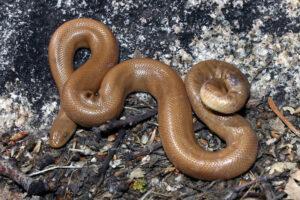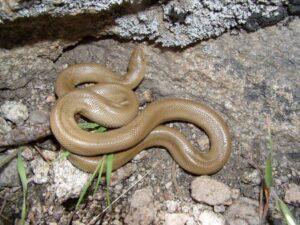The southern rubber boa is a small, stout snake endemic to southern California, United States. Its common name owes to the smoothness of its skin, resembling rubber. Though an excellent swimmer, climber, and burrower, its secretive nature has prevented collecting it from gathering enough data.
Scientific Classifications
- Suborder:Serpentes
- Family:Boidae
- Genus:Charina
- Species:C. umbratica
Conservation Status
Description
Size
The average length of the boa is 11-15 inches. For a male, the maximum size can go up to 19.5 inches, while it is 22 inches for a female.
Color and Appearance
The dorsal color can be olive-green, reddish, chocolate brown, pink, or tan. It can be orange, yellow, or cream on the ventral side. Usually, there is no pattern, but sometimes there can be dark mottling. Its body is covered with smooth, shiny small scales.
Its small eyes have vertically elliptical pupils. But big scales cover the top of its head.
Are They Dangerous to Humans
Being non-venomous, the constrictor poses no danger to humans. When threatened, it hides its head in its coils and raises its blunt tail (which is the same size as its head) to fool the attacker into thinking it is its head. So its tail can often be found to have scars.
Southern Rubber Boas at a Glance
Distribution
The boa can be found across San Jacinto and San Bernardino mountains in southern California at elevations between 4,900 ft and 7,900 ft.
Habitat
It thrives in coniferous forests and woodlands with developed soils and good vegetation. The inhabited areas typically contain accumulated organic debris that can hold a lot of moisture, a condition the snake prefers.
It takes shelter and burrows in outcrops, tree debris, and loose and developed soils.
Predators
The California striped racer and kingsnakes are known predators. Ring-necked snakes and night snakes are also presumed to feed on them.
Diet
It eats birds and small mammals. Its tendency to feed on lizard eggs rather than the lizards makes it different from other rubber boas.
Reproduction
Ovoviviparous (gives birth to live young from eggs that hatch inside the body)
Mating occurs immediately after the females emerge from hibernation in April and continues till May. A female loses around 47% of its weight during gestation and gives birth to 2-8 young from late summer through autumn.
Source
content.eol.org, content.eol.org







